Originally posted on November 17, 2023 @ 4:44 am
Are you looking for a substitute for habanero peppers? Whether you can’t find them in your local grocery store or you simply want to try something new, finding a suitable alternative can be challenging. But don’t worry, we’ve got you covered! In this article, we’ll guide you through various options that can provide the same heat and flavor as habanero peppers.
Table of Contents
Key Takeaways
- Substituting habanero peppers can be challenging, but there are many alternatives available
- Understanding the heat level and flavor profile of habanero peppers is essential when choosing a substitute
- Some substitutes offer a similar level of heat, while others provide unique flavor profiles
- Adjusting the quantity and usage of substitutes is important to achieve the desired level of spiciness in your dishes
- Always handle spicy peppers with caution and wash your hands thoroughly after handling
Understanding Habanero Peppers
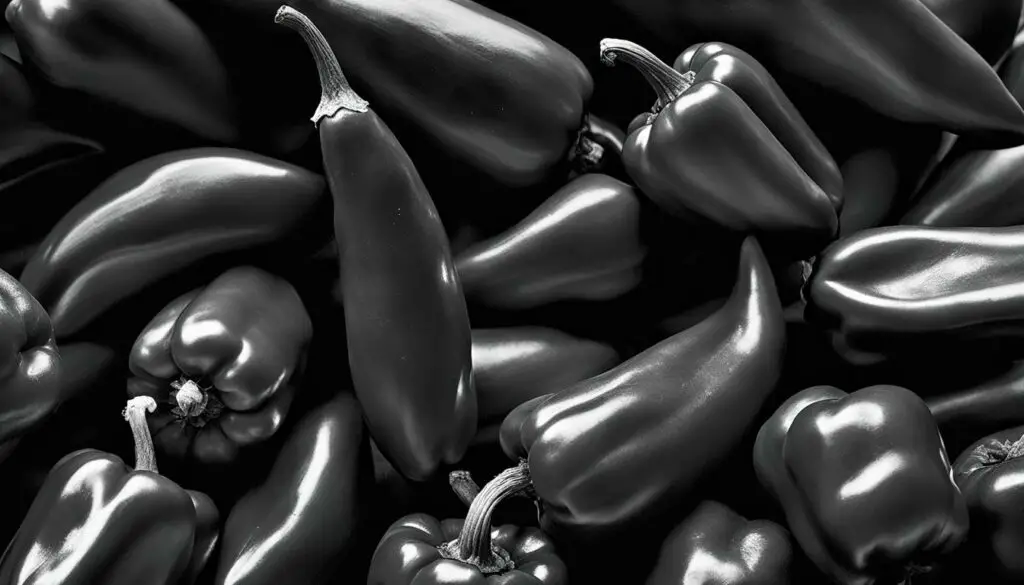
Before we dive into the world of habanero pepper substitutes, let’s first understand these fiery peppers. Habaneros belong to the Capsicum chinense species and are known for their fruity flavor and intense spiciness.
These peppers typically come in shades of orange or red and rank high on the Scoville scale, which measures the spiciness of chili peppers. Habaneros can range from 100,000 to 350,000 Scoville heat units, making them one of the hottest peppers in the world.
Habanero peppers are popular in various cuisines worldwide for their unique taste and level of spiciness. While they can add a delicious kick to numerous dishes, they may not always be available or accessible to everyone. That’s where habanero pepper substitutes come in handy.
Let’s explore some spicy pepper substitutes and habanero alternatives that can help you achieve the desired level of heat in your dishes.
Spicy Pepper Substitutes and Habanero Alternatives
| Pepper Substitute | Scoville Heat Units | Flavor Profile |
|---|---|---|
| Serrano Peppers | 10,000 to 25,000 SHU | Grassy, bright, and slightly sweet flavor |
| Jalapeños | 2,500 to 8,000 SHU | Mild to moderate heat with earthy and slightly sweet flavor |
| Cayenne Peppers | 30,000 to 50,000 SHU | Bitter, nutty, and slightly sweet flavor |
| Scotch Bonnet Peppers | 100,000 to 350,000 SHU | Fruity and sweet flavor with a fiery kick |
| Thai Bird’s Eye Chilies | 50,000 to 100,000 SHU | Sharp and spicy taste with fruity and slightly sour notes |
These habanero pepper substitutes and alternatives offer a range of heat levels and flavor profiles. Some provide a similar heat profile to habanero peppers, while others offer a unique taste to explore.
When using these spicy pepper substitutes, remember to adjust the quantities and usage based on your preference. Start with a small amount and gradually increase to find the right level of heat for your taste buds.
Now that we understand habanero peppers and their alternatives, let’s explore some flavorful substitutes for unique taste profiles in the next section.
Scoville Scale: Heat Equivalents
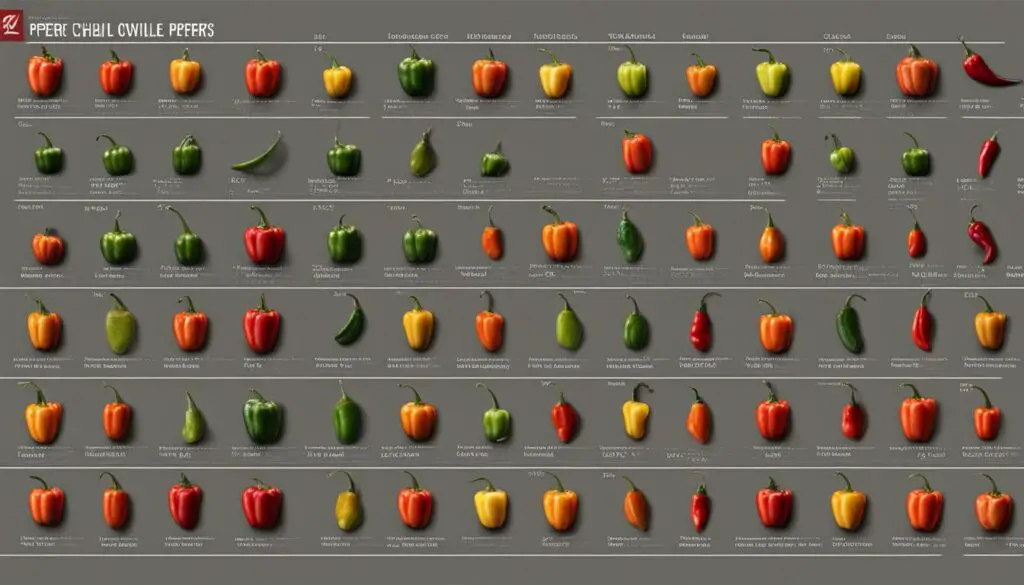
If you’re searching for a habanero pepper substitute based on heat level, it’s helpful to understand the Scoville scale. This scale measures the spiciness of chili peppers. Here are some chili pepper substitutes that offer a similar level of heat:
| Pepper | Scoville Heat Units |
|---|---|
| Serrano peppers | 10,000 to 25,000 |
| Jalapenos | 2,500 to 8,000 |
| Cayenne peppers | 30,000 to 50,000 |
Each of these chili peppers can be used as a suitable substitute that offers comparable heat to habanero peppers.
If you’re looking for a milder alternative, banana peppers or Anaheim peppers provide a subtle heat that can still add flavor to your dishes. Crushed red pepper can also work as a milder substitute.
It’s essential to keep in mind that the heat level of chili peppers can vary based on their origin, growing conditions, and other factors. Taste and adjust the quantity of the substitute based on your preference and recipe requirements.
Flavorful Alternatives to Habanero Peppers
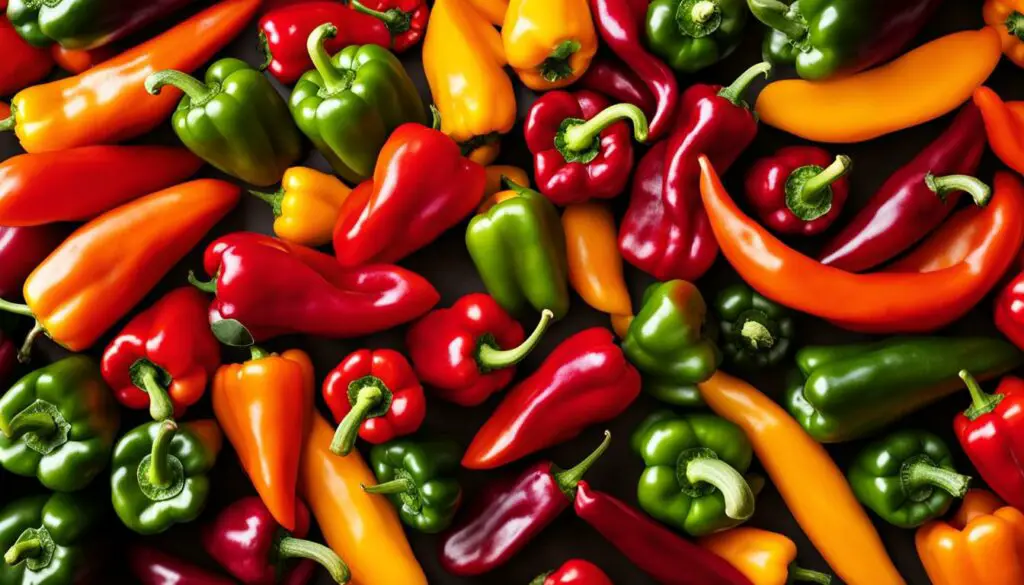
If you’re seeking substitutes that offer both heat and flavor similar to habanero peppers, there are several options to explore. Consider ingredients like Scotch bonnet peppers, Thai bird’s eye chilies, or red pepper flakes. These alternatives can provide a similar taste profile, allowing you to maintain the desired spicy kick in your recipes.
Let’s take a closer look at these flavorful substitutes:
| Substitute | Heat Level (Scoville Units) | Flavor Profile |
|---|---|---|
| Scotch Bonnet Peppers | 100,000 to 350,000 | Earthy and fruity with a citrusy aroma |
| Thai Bird’s Eye Chilies | 50,000 to 100,000 | Sharp and pungent with a slightly sweet taste |
| Red Pepper Flakes | 30,000 to 50,000 | Smoky and slightly sweet with a mild bitterness |
Scotch bonnet peppers are one of the closest substitutes to habanero peppers, with a similar level of heat and fruity flavor. They are commonly used in Caribbean and West African cuisines and can be found fresh or dried. Thai bird’s eye chilies, on the other hand, are smaller and pack a sharp, pungent punch in a dish. They are a great substitute for habanero in Asian dishes, such as curries and stir-fries. Red pepper flakes offer a smokier taste profile, often used in Italian cuisine and dishes like pasta and pizza.
Experiment with these flavorful alternatives to habanero peppers and discover new combinations that complement your favorite cuisines.
Milder Substitutes with a Hint of Heat
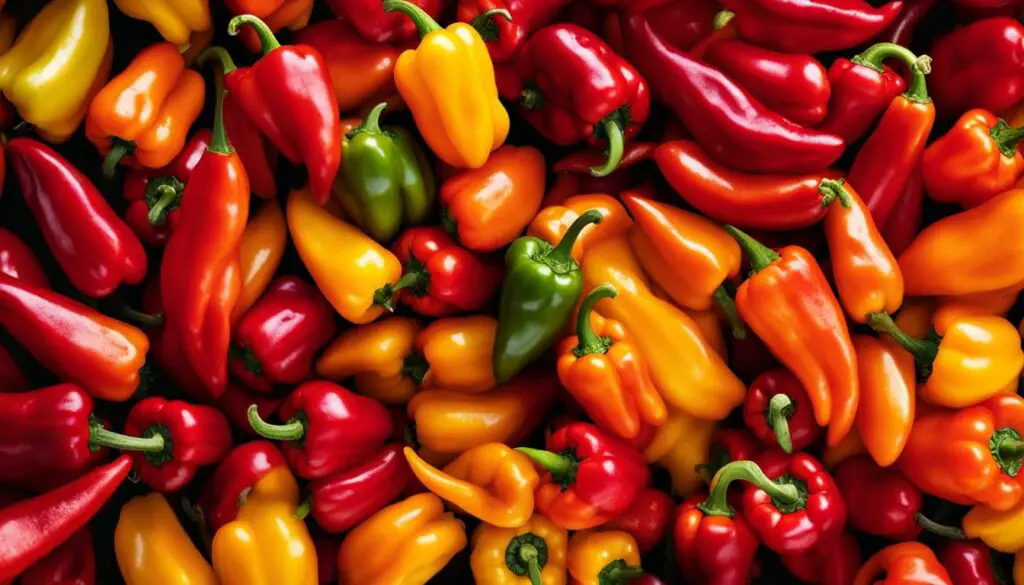
If you’re not a fan of the intense heat of habanero peppers, there are still plenty of options to add a touch of spiciness to your dishes.
Banana peppers: These mild, sweet peppers have a Scoville rating of 0-500, making them an excellent substitute for habaneros in terms of flavor. They offer a subtle heat that won’t overpower other ingredients and work well in salads, sandwiches, and pizzas.
Anaheim peppers: Similar to banana peppers, Anaheim peppers have a mild, fruity flavor and a heat rating of 0-1,000 Scoville units. They work well in recipes that require a gentle heat, such as omelets, casseroles, and roasted vegetables.
Crushed red pepper: If you’re looking for a versatile substitute, consider crushed red pepper flakes. These flakes come from dried chili peppers and can range from mild to spicy, depending on how much you use. They are an excellent addition to pasta dishes, stir-fries, and marinades.
While these substitutes won’t match the exact heat level of habanero peppers, they are perfect for those who prefer a milder alternative. Don’t forget to adjust the quantities and usage based on the substitute you choose to maintain the desired level of spiciness in your dishes.
Unique Substitutes for Unique Flavors
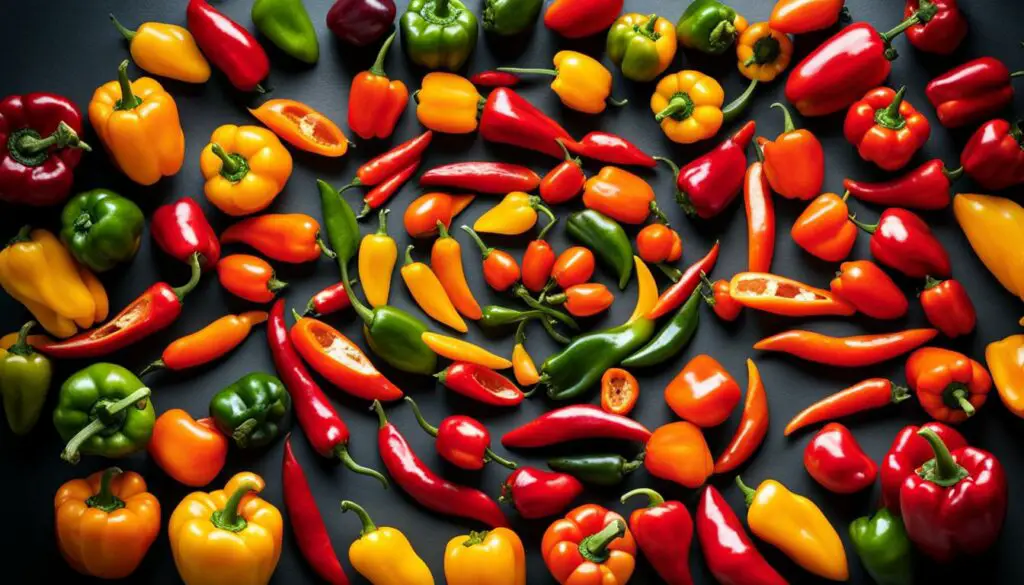
When it comes to finding habanero flavor substitutes, why limit yourself to the basic options? Here are some unique alternatives to explore:
Chipotle Peppers
Smoked jalapeno peppers, also known as chipotle peppers, offer a slightly sweet and smoky flavor, along with moderate spiciness. They work well in sauces, marinades, and dressings.
Korean Gochugaru
A staple in Korean cuisine, gochugaru provides a fruity, slightly sweet flavor and moderate spiciness. It is commonly used in kimchi, stews, and soups.
Wasabi
Originating in Japan, wasabi offers a distinct, pungent flavor with a sharp kick of heat. It can be grated and used as a condiment for sushi, or added to dressings and sauces for extra heat and flavor.
TIP: Be cautious when working with wasabi, as it has a strong heat that can quickly become overwhelming. Use it sparingly and taste often.
These habanero flavor substitutes may not offer the same level of heat as their namesake, but they can add exciting new flavors to your dishes. Experiment with them in your favorite recipes to discover new taste combinations.
Balancing Heat and Flavor
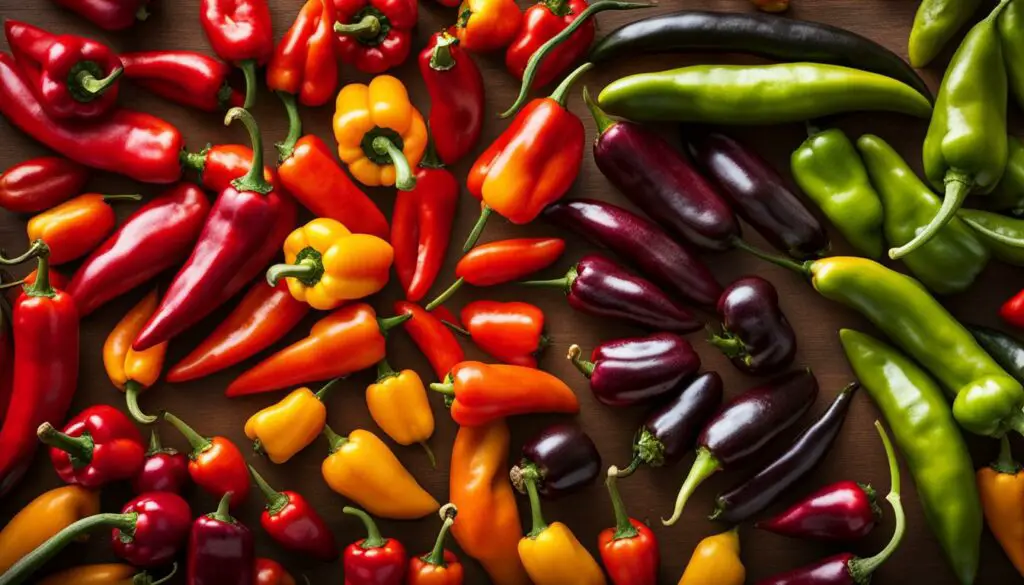
Achieving the perfect balance between heat and flavor is crucial when substituting habanero peppers.
First, consider the substitute’s heat level. If you’re using a substitute that’s milder than habanero pepper, you may need to add more of it to achieve the same level of spiciness.
Next, be mindful of the substitute’s flavor profile. Habanero peppers are known for their fruity taste, so if you’re using a substitute that has a different flavor, adjust the recipe accordingly.
When cooking with habanero substitutes, remember to taste and adjust as needed.
Tip: Use substitutes like cayenne pepper or red pepper flakes sparingly as they can quickly overpower other flavors.
Substituting Habanero Peppers in Salsa Recipe
Here’s an example of how to balance heat and flavor when substituting habanero peppers in a salsa recipe:
| Ingredient | Amount |
|---|---|
| Canned diced tomatoes | 1 can (14.5 oz) |
| Red onion, diced | 1/2 cup |
| Lime juice | 3 tablespoons |
| Jalapeno pepper, seeded and diced | 1 |
| Red pepper flakes | 1/2 teaspoon |
| Serrano pepper, seeded and diced | 1 |
In this recipe, we substituted habanero pepper with a combination of jalapeno and serrano pepper, with the addition of red pepper flakes for extra heat. Start by adding half of the peppers and red pepper flakes, and gradually increase to adjust the heat to your preference.
As you experiment with habanero pepper substitutes, remember to have fun and let your taste buds be your guide. With a little bit of trial and error, you can find a substitute that adds the perfect amount of heat and flavor to your favorite dishes.
Tips for Using Habanero Pepper Substitutes
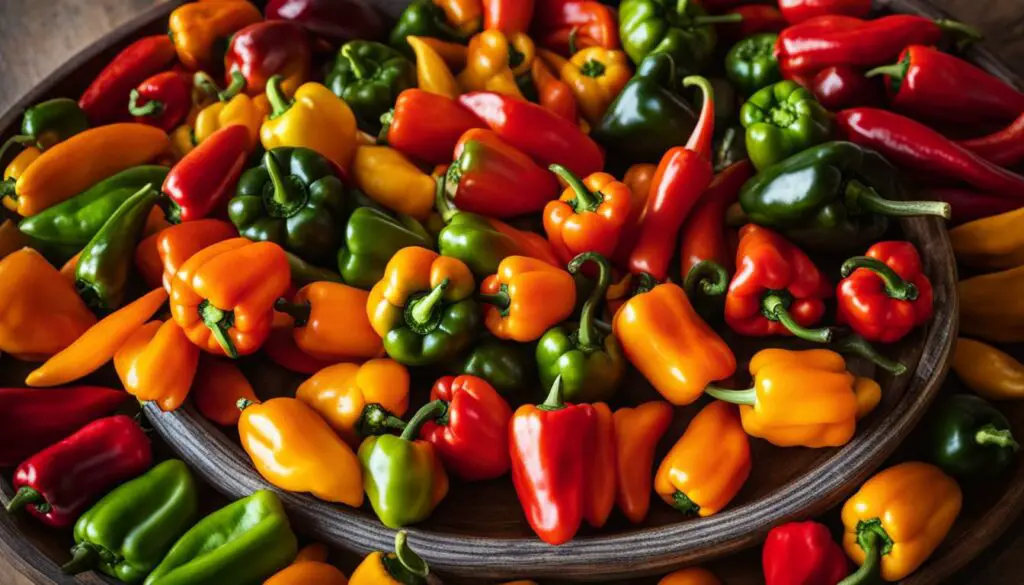
When using habanero pepper substitutes, there are a few tips to keep in mind. Since the substitutes can vary in heat level and flavor, it’s best to start with a small amount and gradually increase to reach your desired spiciness. Remember to adjust the quantities and usage based on the substitute you choose. Some alternatives may have a slightly different heat profile, so make sure to taste and adjust accordingly to maintain the desired level of spiciness in your dishes.
Another tip is to remove the seeds and membranes of the substitute pepper to reduce the heat level if you prefer a milder flavor. However, if you’re looking for maximum heat, leave them in. Remember to handle spicy peppers with caution and wash your hands thoroughly after handling to avoid any irritation.
When substituting habanero peppers with other chili pepper substitutes, it’s also important to keep in mind the differences in flavor profiles. The substitutes may not have exactly the same taste as habanero peppers, so it’s essential to experiment and adjust the quantities accordingly.
By following these tips, you can successfully incorporate habanero pepper substitutes into your recipes and enjoy the perfect spicy flavor without compromising on taste.
Cooking with Habanero Pepper Substitutes
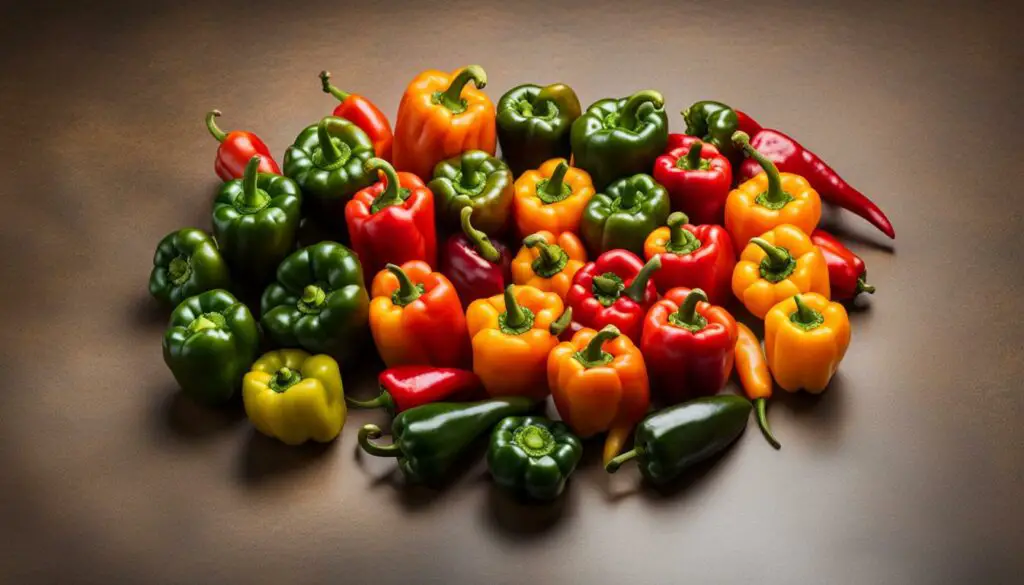
Now that you’ve found the perfect habanero pepper substitute, it’s time to get creative in the kitchen. Cooking with fiery pepper substitutes, habanero flavor substitutes, and other spicy ingredient alternatives can bring a new level of flavor to your dishes. Here are a few tips for incorporating habanero pepper substitutes in your recipes.
Experiment with different dishes
Don’t be afraid to experiment with habanero pepper substitutes in a variety of dishes. These alternatives can be used in everything from hot sauces to marinades to soups and stews. Try using them as a substitute in your favorite recipes or discover new dishes that showcase their unique flavors.
Adjust quantities to taste
When using habanero pepper substitutes, it’s essential to adjust the quantity based on your desired level of spiciness. Start with a small amount and gradually increase until you achieve the desired heat. Remember that different substitutes may have slightly different heat profiles, so be sure to taste and adjust accordingly.
Remove seeds and membranes
If you prefer a milder flavor, consider removing the seeds and membranes of the substitute pepper. This can tone down the spiciness while still incorporating the flavor into your dishes.
Handle with care
Always remember to handle habanero pepper substitutes with care. Wear gloves if necessary, and wash your hands thoroughly after handling to avoid any skin irritation.
Cooking with fiery pepper substitutes, habanero flavor substitutes, and other spicy ingredient alternatives can be a fun and exciting way to add some heat to your dishes. With a little experimentation and adjustment, you can achieve the perfect balance of flavor and spiciness.
Incorporating Habanero Pepper Substitutes in Recipes
Now that you’ve found the ideal habanero pepper substitute, it’s time to put it to use in the kitchen. These alternatives can add a unique and exciting flavor to your favorite recipes, and they’re perfect for experimenting with different flavor profiles. Try out these ideas to incorporate habanero pepper substitutes in your cooking:
Spicy Sauces
Create a homemade hot sauce using your substitute pepper, vinegar, and other spices. Use it as a dip or drizzle it over your favorite dishes for a fiery kick.
Spicy Shrimp
Grill or sauté shrimp with your substitute pepper and garlic for a quick and easy meal. Serve with rice or vegetables for a balanced and flavorful dish.
Spicy Marinades
Marinate chicken or beef with your substitute pepper, lime juice, and spices for a bold and zesty flavor. Grill or bake the meat for a delicious meal that’s sure to impress.
Spicy Salsas
Add your substitute pepper to a tomato-based salsa for an extra kick of heat. Serve with tortilla chips or as a topping for tacos, burritos, or quesadillas.
Experiment with different cuisines, such as Thai, Mexican, or Caribbean, to discover how your substitute pepper can enhance the flavors of various dishes. Don’t be afraid to try new things and adjust the quantities based on your preferred heat level.
Remember to handle spicy peppers with caution and wash your hands thoroughly after handling to avoid any irritation. Enjoy the versatility of your habanero pepper substitute and let your taste buds guide you on a flavorful journey.
Conclusion
Finding the perfect habanero pepper substitute can be a game-changer in the kitchen. Whether you’re looking for equal heat or unique flavors, the alternatives we’ve explored in this article can help you achieve the desired spicy kick. Remember to adjust the quantities and usage based on the substitute you choose, and be sure to handle spicy peppers with caution.
From flavorful alternatives to milder substitutes with a hint of heat, there are so many options to choose from. Experiment, taste, and have fun discovering new combinations that satisfy your cravings for fiery flavors. Incorporate your chosen habanero alternatives seamlessly into your favorite recipes, from spicy sauces to shrimp dishes, and let your taste buds be your guide.
Whether it’s for availability, personal preference, or dietary restrictions, we have you covered when it comes to finding the ideal habanero flavor substitutes. Embrace the versatility of these alternatives and elevate your dishes with their unique flavors and heat. Happy cooking!
FAQ
What are habanero peppers?
Habanero peppers are fiery hot peppers known for their fruity flavor. They belong to the Capsicum chinense species and are typically orange or red. They rank high on the Scoville scale, measuring around 100,000 to 350,000 heat units.
Why would someone need a substitute for habanero peppers?
There are several reasons why someone may need a substitute for habanero peppers. It could be due to the unavailability of habaneros, personal preference for milder peppers, or dietary restrictions that prohibit the use of habaneros.
How can I find a substitute based on the heat level of habanero peppers?
Understanding the Scoville scale can help you find a substitute based on the heat level of habanero peppers. Consider alternatives such as serrano peppers, jalapenos, or cayenne peppers, which have similar heat levels.
What are some alternatives to habanero peppers that offer both heat and flavor?
If you’re looking for substitutes that offer both heat and flavor similar to habanero peppers, consider ingredients like Scotch bonnet peppers, Thai bird’s eye chilies, or red pepper flakes.
Are there milder substitutes for habanero peppers?
Yes, if you prefer a milder substitute that still adds a touch of heat, options like banana peppers, Anaheim peppers, or crushed red pepper can work well.
Can I use unique substitutes for habanero peppers that bring a different flavor?
Absolutely! If you’re looking to introduce unique flavors to your recipes, consider experimenting with chipotle peppers, Korean gochugaru, or even wasabi.
How can I balance the heat and flavor when substituting habanero peppers?
Achieving the perfect balance between heat and flavor is crucial when substituting habanero peppers. Remember to adjust the quantities and usage based on the substitute you choose.
Any tips for using habanero pepper substitutes?
Start by using a small amount and gradually increase to adjust the heat to your preference. Also, remove the seeds and membranes of the substitute pepper if you prefer a milder flavor. Handle spicy peppers with caution and wash your hands thoroughly after handling to avoid irritation.
How can I incorporate habanero pepper substitutes in recipes?
Once you’ve found the perfect substitute, get creative in the kitchen. Experiment with different recipes and cuisines to explore the versatility of your chosen substitute.
How do I incorporate habanero pepper substitutes seamlessly into my favorite recipes?
Explore how different substitutes can enhance the flavor and heat of your culinary creations. From spicy sauces to spicy shrimp dishes, let your taste buds guide you.
What does finding the perfect habanero pepper substitute offer?
Finding the perfect habanero pepper substitute opens up a world of possibilities in the kitchen. Whether you’re looking for equal heat or unique flavors, the alternatives mentioned in this article can help you achieve the desired spicy kick.
See also:
Leave a Reply